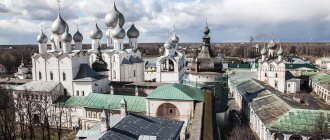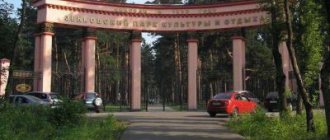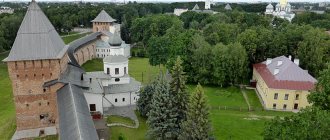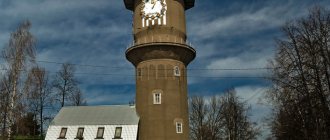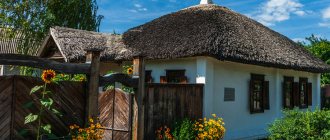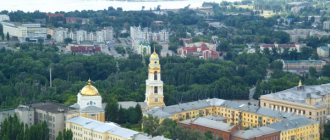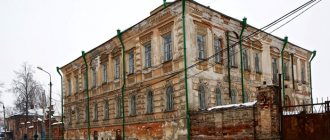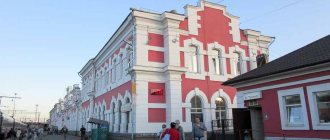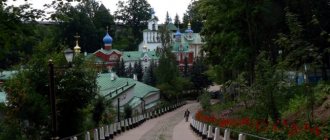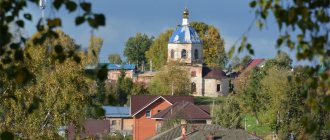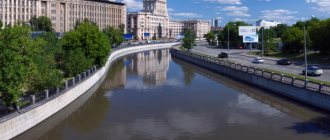To say that you have seen Rostov, it is enough to come here for one day and visit two places: the Kremlin and the Spaso-Yakovlevsky Monastery. The city is small, and you will definitely have time, but I advise you to come for the whole weekend and take a leisurely walk around Rostov, leafing through this guide on your phone.
I tried to put things in order in my head and create a guide to Rostov the Great. I am often on the M8 highway in the Rostov region and when I have time, I go into the city. You can do the same if you are driving along the Moscow-Yaroslavl highway. While passing through, you will take a walk around the Kremlin and then move on.
View from the porch of the Red Chamber. In the background is the Assumption Cathedral
Rostov is a very ancient city. It was first mentioned in the Tale of Bygone Years in the entry of 862 already as an existing city of the Merya tribe. And what’s interesting is that it is mentioned precisely in the entry where our ancestors call on Rurik to reign over Rus'. Remember these words: “Our land is great and abundant, but there is no order in it...”? Still relevant. Two interesting facts:
- Rostov is the birthplace of the epic hero Alyosha Popovich.
- The film “Ivan Vasilyevich Changes His Profession” was filmed in the Rostov Kremlin.
What to see in Rostov
Attractions in Rostov-Veliky are divided into two groups: the Kremlin and all the rest.
Among all the others, the most interesting are the Spaso-Yakovlevsky Monastery and the Museum of Enamel.
Main advice: The Kremlin is a mandatory program, and you already have enough time to add to it.
Rostov Kremlin
Metropolitan's courtyard in winter
The Rostov Kremlin is not difficult to find in the city.
All roads lead to him. From the bypass, you enter the city along any road and drive straight until you hit the Kremlin wall.
Interesting fact: the Kremlin is not actually a Kremlin.
Until the mid-18th century it was not even called by this word.
In fact, this is the residence of the Rostov-Yaroslavl Metropolitan. No matter how powerful this structure may look, its function is purely decorative. It can only protect against petty hooligans.
The windows do not reveal the defensive function of these walls.
You don’t even need to measure their thickness and height. There should be no windows on real Kremlin walls, only loopholes. And Rostov had no strategic significance during the construction of the Kremlin.
The ramparts around the Kremlin are also not for defense. About them below.
The Kremlin was built by Metropolitan Jonah Sysoevich at the end of the 17th century. He wanted to make his residence similar to the description of heavenly Jerusalem. It turned out beautiful.
View of the Rostov Kremlin from above. In the foreground are the roofs of 19th-century shops. Behind them is Gostiny Dvor (on the left) and Cathedral Square of the Kremlin (on the right). Inside Gostiny Dvor there is a Church of the Savior on the market. In the background is Lake Nero / photo by Grigory Yaffa
The Rostov Kremlin consists of three parts:
- Cathedral Square (free admission)
- Metropolitan's Courtyard
- Metropolitan Garden
All these areas are surrounded by a wall.
Cathedral Square
Entry here is free.
There are gates on two sides: the Holy Gate in the western wall and a small gate near the belfry. On the side of the Holy Gate there is a parking lot and shops with souvenirs. You don’t have to worry about parking; there are plenty of places to leave your car around the Kremlin.
Still from the film “Ivan Vasilyevich changes his profession.” The corner of the Assumption Cathedral is visible on the right
On the cathedral square there is a large, white and very ancient Assumption Cathedral, next to it is a belfry. On the belfry one flight is larger than the others; there hangs a huge Sysoy bell. Opposite the cathedral is a powerful wall with two round towers and the domes of the Church of the Resurrection above them. Between the towers there is a narrow passage into the courtyard.
Remember the scene from the film “Ivan Vasilyevich Changes His Profession”, from this square the tsar’s army went to war.
Belfry
At the Rostov belfry. Sysoy is the farthest
The main attraction of the belfry is the huge bell of Sysoy. It weighs 32 tons (2000 pounds). It's like a Kamaz loaded with crushed stone. Casting a product of this size is not easy even today.
The bell was made in 1688, during the early years of the reign of Peter I and his older brother Ivan V.
The bell hangs in the high part attached to the main belfry. Currently, it is almost not used due to its antiquity.
You can climb the belfry for 100 rubles. The passage through the narrow staircase is regulated by a traffic light. Two people inside will not be able to separate.
Assumption Cathedral
Rostov Kremlin: Assumption Cathedral (right) and Belfry (left) / photo by Grigory Yaffa
Built under Vasily III, father of Ivan the Terrible, in 1512. The cathedral is made of brick, but stands on a base of white stone. It remains from a 12th century temple built under Andrei Bogolyubsky. Before that, there was some kind of wooden temple here, about which nothing is known.
Inside, a huge iconostasis from the first half of the 18th century has been preserved.
Entrance to the cathedral is free. It's very cold inside, even in summer.
Kremlin courtyard
This is the Metropolitan's courtyard.
Entrance to the Kremlin territory is paid - 50 rubles. From the side of the cathedral square, a long corridor leads through the wall. It has a cash register. Another entrance to the Kremlin is from the western side through a heavy door in the Church of St. John the Theologian. There is also a cash register there.
The ticket office is open from 10:00 to 17:00.
If you entered the Kremlin through Cathedral Square, then in front of you there will be a pond, behind it the entrance to the garden, on the right is the Church of Hodegetria, there is a path to the ticket office slightly to the right, a cafe and a hotel on the left.
Shadows of the domes on the wall of the White Chamber
It is better to walk around the Kremlin clockwise.
At the box office (any one) you buy a ticket for the exhibitions you want to see.
It’s better to buy a single ticket for 550 rubles and get around everything you have time for. It’s possible to get around the Kremlin in a day; it’s small.
See prices for individual exhibitions on the Kremlin website. Scroll down the page, there are prices for the Kremlin hotel.
In the Kremlin I recommend visiting:
- White Chamber,
- Exposition “Rostov land. One Hundred Centuries of History"
- Exposition “Treasures of the Rostov Kremlin”,
- Museum of Enamel,
- Cafe.
Church of Hodegetria
Church of Hodegetria. On the second floor you can see the terrace
The outside of the church is distinguished by its unusual coloring: a beige three-dimensional ornament instead of the traditional white color. The building is decorated with columns; a beam encircles the entire church at the second floor level.
The church was built at the end of the 17th century, later than other Kremlin buildings. There is currently an exhibition in the church.
Admission is paid, buy a ticket at the Kremlin box office.
Red Chamber
A two-story white building with beautiful windows and an awesome porch.
On the ground floor under the porch there is a restaurant and toilets there. On the second floor there is a museum of church antiquities. I advise you to come here, the museum is small, but there is something to see.
Metropolitan Garden
The last part of the Kremlin is the Metropolitan Garden. You can only enter from the Kremlin territory. There is a small passage in the wall.
Rostov Kremlin. The Metropolitan's garden is in the foreground on the left. The corner tower in the garden is called Sadovaya. The next one, square in the center, is Drovyanaya. The next corner tower is the Fortress. Behind the three towers is the Church of the Savior on Senya, from behind which Samuil's building is visible. The small church on the left is the Church of St. Gregory the Theologian / photo by Gregory Yaffa
It seemed strange that the Rostov Kremlin was pink in places.
Peter I once called Lake Nero a dirty puddle and chose nearby Lake Pleshcheyevo for his fleet.
Notice the "Calendar" button at the top. Click it, enter your arrival dates and the site gives you a list of events and museums open on those days.
Also stop by the Church of St. John the Evangelist. This is the one above the western gate. Just don’t confuse it with the wooden Church of St. John the Evangelist near Rostov. Inside it is completely covered with frescoes, it is very light and it all looks very beautiful. Unusually, the pulpit is located very high. Usually the elevation is quite small, but here the height is more than a meter. Again, Jonah wanted to be taller than the rest and look down on the parishioners during services.
What to see besides the Kremlin
Museum of Rostov Merchants (Kekin House Museum)
Alexey Leontievich Kekin is a Rostov merchant who donated a lot of money for the development of his city.
The museum is very small, there are few exhibits. The interiors of the house are shown very roughly. The original interiors have not been preserved; during the USSR there was a technical school here.
Instead of this museum, I advise you to read below about the gymnasium and look at it from the outside. If you go to a museum, then take a tour. Otherwise it won't be interesting.
The museum is open from 10:00 to 17:00 , except Mondays and Tuesdays.
Kekina Gymnasium
Looking at her, you begin to envy her students.
Kekina Gymnasium in 1911. The observatory dome is visible on the right side of the building. On the left is the building a little lower, these are former apartments for teachers / photo by S. M. Prokudin-Gorsky
Alexei Leontievich's only heir died in 1885, and he bequeathed all his capital to the city. According to the will, the money should have been spent on the construction of a men's gymnasium and a university. But the latter didn’t work out because of the revolution, but they managed to build a gymnasium.
The cost of studying at the gymnasium was 30 rubles per year. This is a little more than the monthly salary of a worker or school teacher. With this money you could rent a room in the city for a month, eat normally and still have some left over. Approximately half of the children in the gymnasium studied for free. At the same time, education in Moscow gymnasiums cost 60 rubles per month.
The building is huge, decorated with columns and statues. At the time of construction it was the largest gymnasium in Russia. There was even an observatory built in the gymnasium, which is still in operation today.
The gymnasium has two buildings: an educational building and a residential building for teachers. They are connected by a passage at the second floor level.
You won't be able to get inside. Although, maybe they will make an exception for you. Give it a try.
Earthen fortress
The only 17th-century earthen fortress in Russia in almost original condition.
It is impossible to take in the entire scale of this structure from the ground. The entire fortress can only be seen from above. Do not be confused, these are not the ramparts of the Rostov Kremlin, this is an earthen fortress, which was built by a Dutch engineer commissioned by Tsar Mikhail Fedorovich (the first Romanov).
In 1634, the fortress was built as a model for demonstration to the king.
A gun trench was built along the top line of the ramparts. Below, along the outer perimeter, the fortress was surrounded by a dry ditch, around it there was a low rampart, and a large ditch with water surrounded it all.
The fortress is very well preserved. Moats, in some places even with water (near Victory Park), 6 bastions, curtain walls - everything is in its original form. Only roads were built in a few places.
Church of the Ascension
In one of the bastions there is the Church of the Ascension of the Lord. This is the most ancient temple in Rostov. It was built under Ivan the Terrible. Rostov, by the way, was part of the Oprichnina.
During the construction of the fortress, the church was added to the bastion.
Draw on glass
Enamel in the Kremlin
Be sure to come here.
Enamel is an image made with fireproof paints on jewelry enamel on a metal base. Essentially, it is a painting on glass. Only they burn it again, and the picture becomes almost eternal.
The frame is usually made of openwork and very thin from soft metal. Therefore, products such as bracelets, earrings, and pendants do not last long.
The museum contains images made back in the 18th century, that is, at the time when Rostov enamel first appeared. The pictures are beautiful and bright, they always remain that way. All this is handmade.
Then you can buy yourself a souvenir with enamel. Where and how much, read below.
Enamel at the factory
At the factory, in addition to finished products, you will also be shown production. There are also master classes here. The master class costs 300 rubles, entrance to the museum is 90 rubles. But this is without a tour.
Lake Nero
This is a view of the Spaso-Yakovlevsky Monastery from Lake Nero / photo by Gregory Yaffa
I wouldn't call it very beautiful - just an ordinary lake. The bottom is muddy, the banks are overgrown with grass, there are no great depths. There is a beach in the city, but swimming is prohibited here; you can be fined for swimming. Please sunbathe, but do not swim.
But Rostov looks beautiful from the lake. You can see it from board a pleasure boat or boat. There are berths on the shore near the Kremlin.
Drink water that smells bad
After the Kremlin, this is the second most important attraction in Rostov. Not water, of course, but the Spaso-Yakovlevsky Monastery , which has a source of mineral water. The taste is normal, but the smell is specific.
View of the Spaso-Yakovlevsky Monastery. In the center, with columns, is the St. Demetrius Cathedral, and in the lower right corner there is a booth, this is the source / author of the photo - Gregory Yaffa
You can get to the monastery on foot along the lake shore from the Kremlin. You can walk there in 40 minutes at a leisurely pace. First along the well-maintained embankment, then along the unimproved one.
There are two interesting things about the monastery: the architecture and the holy spring.
Columns and statues, like those of ancient Greece, decorate Orthodox churches.
The source is located in the wooden chapel of St. James, just to the right of the central alley. There are mugs inside, and if you want to take some water with you, you can purchase a bottle at the entrance to the monastery. But it's better to bring your own.
View of the Spaso-Yakovlevsky Monastery from the city side / photo by Gregory Yaffa
Also go to St. Demetrius Cathedral . It was built with the money of Count Nikolai Sheremetyev.
The sun sets behind this monastery in autumn. Go out in the evening to the embankment of Lake Nero near the Kremlin in September or November and look towards the monastery. It's on the right. It will be beautiful.
Museum-Reserve "Rostov Kremlin"
Rostov-Yaroslavl Museum of Architecture and Art…
Rostov
In 1883, the Museum of Church Antiquities opened in the White Chamber of the Rostov Kremlin; later it received the status of an all-Russian museum. The Kremlin has finally lost its religious function, but the presence of a museum on its premises has made it possible to preserve the architectural ensemble of the former residence.
Today, the Rostov Kremlin Museum-Reserve displays more than 180 thousand valuable exhibits, among them ancient Russian icons, Yam bells, and an altar cross from the 16th century. Here is the largest collection of enamel items in Russia - about 2.5 thousand miniatures from the 18th to 20th centuries.
How to go to Rostov
There is a bus and a train to Rostov, but both stations are far from the center, on the outskirts, but you can get there on foot faster than waiting for the bus. The small town.
By car
From Moscow you need to go towards Yaroslavl along the M8 (via Mytishchi). It takes 2.5-3 hours to drive from the Moscow Ring Road.
From Ivanovo, exit through Novo-Talitsy and then either straight to Teykovo and further through Ilyinskoye, or right to Gavrilov Yam. The drive takes 2.5-3 hours.
From Yaroslavl along Moskovsky Prospekt from the center all the time straight. You will arrive in 45-60 minutes.
It’s easy to drive along the Moscow-Yaroslavl highway. Almost everywhere there are 2 lanes in both directions.
By train
All trains to Rostov Veliky go from Yaroslavsky station. There is one Arkhangelsk train that departs from Belorussky.
The train takes 3.5 hours.
Don't forget about the opportunity to hitch a ride. Look for a car driving in your direction on the BlaBlaCar website. On the other hand, drivers can also save on gasoline by taking travel companions. You won’t be able to make money, but the journey may turn out to be free.
By bus
From Moscow to Rostov you can take any bus towards Yaroslavl or Vologda. There are about 25 buses every day. All of them depart from the VDNH bus station.
A ticket to Rostov costs about 500 rubles. Buses run from Shchelkovsky bus station.
You can also get from Yaroslavl by anything that goes to Moscow. There are a lot of buses. Bus station in Yaroslavl on Moskovsky Avenue.
What to bring from Rostov
Enamel
About enamel, I think everything is clear. Good products with enamel are real works of art.
There is a lot of enamel in Rostov and it is expensive, although some simple jewelry is sold for 300 rubles or even cheaper. But something really beautiful, for example a box, costs from 1000 rubles.
It is better to buy in a store at an enamel factory, although you can also buy small items in souvenir shops around the Kremlin.
Bell
Some time ago, a popular Rostov souvenir was a clay bell. Now they are no longer so popular. There is nothing special about the bells, they just remind you of the large Sysaya bell that hangs in Rostov.
Ceramics
You need to buy black-polished ceramics. It looks just matte black, without glaze. This color is obtained by smoking products in smoke.
Assumption Cathedral
The exact date of construction of the Assumption Cathedral, which is part of the Rostov Kremlin complex, cannot be established; the temple burned and was rebuilt many times; the brick building of the cathedral from 1512 has survived to this day. Next to the temple there is a belfry. The largest of the 15 bells weighs 32.7 tons.
Inside the cathedral, frescoes from the 16th–17th centuries found during restoration, an iconostasis in the Baroque style, and the relics of Rostov saints and ruling bishops are preserved.
Where to eat in Rostov
Meeting
In the Kremlin, in the Red Chamber.
There is a Sobranie restaurant in the Red Chamber, but it is more for corporate events than for individual relaxation. Everything is somehow big and uncomfortable. We had lunch here once - not good, not bad. The service is slow, they may forget what you ordered, and I didn’t like how they react to criticism. They brought a cold dish, when I asked to warm it up, they made a strange expression on their face and tried to convince me that it was necessary.
The food is delicious. But service can ruin the experience. I got the feeling that the restaurant lives off of corporate events and large groups of tourists (buses are taken here), and they have given up on individual visitors.
Open from 10:00 to 23:00.
Alesha Popovich
There is Russian cuisine, interior, and you can dress in chain mail.
The first one is on Tripadvisor, you can check it out. I haven’t been here, for some reason I didn’t like the facade of the restaurant, although I knew that they had a high rating.
I advise you to come here. I read all the negative reviews and several dozen positive ones. I liked that the administration does not ignore criticism, this is a good sign. We have already written that there are a lot of custom reviews on Tripadvisor. Not everyone can be trusted.
When I'm in Rostov next time, I'll definitely come here and tell you about my impressions.
Where to stay in Rostov
Treat hotels in Rostov with leniency. Everything is good, but each has a bunch of shortcomings that can create a bad impression. Be prepared for broken locks, bad water, power outages, poor maintenance, etc. This applies even to those hotels that have the “Revisorro” and “Tripadvisor” stickers. And it’s cold in all the hotels here.
Read detailed instructions: How to book accommodation online
We recommend two hotels in the center of Rostov. And one more, but with a creak.
Cellar house
It's right in the Kremlin.
Entrance to the hotel House on Cellars
You will be given a pass to enter the Kremlin and park on site. The inside is clean and tidy, but nothing more. The interior is simple. There is a shared toilet on the floor (except for suites), but there are separate toilets for men and women.
You will live on the territory of the ancient Kremlin, surrounded by powerful walls in an ancient building. In the evening, when the museums close and all the tourists have left, the Kremlin will be at your disposal. Walk here all night long.
You can book here .
Hotel Lyon
A good hotel a stone's throw from the Kremlin. Occupies a building from the late 18th century. They have a transfer from the station, you need to call and warn. But in winter it is cold here, like in all other hotels in the city.
The hotel has bicycle rental.
Read more…
Hotel Podozerka
Located by the lake next to the Kremlin. These are all advantages.
I won’t write about the cons. I will only say that the price is higher than in others. I wrote about the existence of this hotel. It's near the Kremlin, but I can't recommend it. The administration is well aware of all the shortcomings and, I hope, this place will improve over time.
Architectural and artistic ensemble of the former Spaso-Yakovlevsky Monastery
Architectural and artistic ensemble of the former Spaso...
Rostov
Panorama of the Spaso-Yakovlevsky Monastery is one of the most picturesque views of Rostov the Great. It combines architectural forms of different styles - classical and baroque church completions, pseudo-Gothic towers.
The monastery was founded by the Rostov bishop Jacob back in the 14th century - he cut down a small wooden temple south of the city. Later, a whole monastery was formed around the church. At the end of the 18th century, the first stone building appeared here - the Trinity Cathedral (the future Conception Cathedral), which was consecrated by the Rostov Metropolitan Jonah Sysoevich. Currently, there are three temples on the territory of the monastery - the Yakovlev Church, the Conception and Demetrius Cathedrals.
What's in the vicinity of Rostov
The tallest bell tower in Russia
But with a caveat: outside the city.
It is located in the village of Porechye-Rybnoye, directly opposite Rostov, on the other side of Lake Nero. You can see it from the Rostov embankment. Bell tower of the Church of Peter and Paul. Even among all the tallest bell towers, it is one of the first on the list. Its height is 94 meters.
It is 20 meters higher than the bell tower in Kalyazin, 22 meters higher than the bell tower in Suzdal and 13 meters higher than the Ivan the Great bell tower in Moscow.
It's just a pity that it's in disrepair. It’s obvious that they tried to restore it, but in such a way that it wouldn’t fall.
Church of St. John the Evangelist on Ishna
Church of St. John the Evangelist on Ishna. Photo from 1911. Since then, little has changed there. /photo by S. M. Prokudin-Gorsky
Built at the end of the 17th century. In principle, nothing special, but you can look here if you have time. You can compare the modern appearance of the church with a photograph from 1911 taken by our favorite photographer Sergei Mikhailovich Prokudin-Gorsky.
Borisoglebsky
It’s not very close, 20 kilometers from Rostov, but you can ride it by car. There is also a monastery with powerful ancient walls. But this is not a museum and there is no entertainment for tourists. Of course, you can go inside the monastery. They have a bell tower with a clock there.
Trinity-Sergius Varnitsky Monastery
If you have a purely religious purpose for traveling to Rostov, you can stay here, I would not recommend it to others. The monastery is outside the city, behind a busy railway crossing, which is closed for a long time.
Keep in mind that at 22:00 the monastery will be closed and if you are late to the hotel, you will have to make arrangements by phone to be let in.
The monastery itself is kept in very good condition: clean, neat, always brightly painted. It’s a long way from the Moscow-Yaroslavl highway, but you can still hear it, just as you can hear passing trains.
Museum of Rostov Merchants
Museum of Rostov Merchants
Rostov
The Museum of Rostov Merchants is located in the building of a merchant estate of the late 18th - early 20th centuries. A family of merchants, the Kekins, lived here from 1835 until the revolution.
The exhibition “Kekins - Family, Fate, Heritage” introduces the history of several generations of a famous family. Using the example of the life of the Kekins, one can trace the culture of the entire Rostov merchant class. The interiors of the living room, dining room, office and boudoir are recreated here. The exhibition presents personal belongings, picturesque portraits and photographs of the Kekin family.
